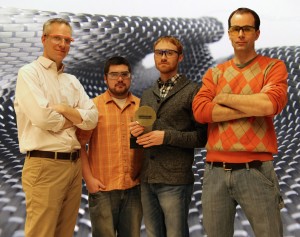Some cool work out of my old group was just published in Advanced Materials. Scientists have been trying to understand the principles underlying the remarkable adhesion of geckos for some time, but the focus had always been on the hierarchical fibrillar microstructure on the gecko’s toe. This new work shows that this microstructure may not be necessary for strong, yet reversible adhesion. Instead, the authors develop a model for adhesion based on the compliance of the mechanisms which lie behind the adhesive pad. Using the model as a guide, they constructed a device based on an adhesive pad attached to a strip of inextensible fabric, capable of holding 700 lbs using a 4″ x 4″ square of dry adhesive. The pad can be unstuck by pulling on the strip in a way which lets the pad peel. This structure echoes the gecko’s own anatomy, where the adhesive skin pads are connected directly to its skeleton using a network of inextensible (but bendable) tendons. This is the first time it’s been shown that such a high load can be supported by a reversible, reusable dry adhesive device. Of course, since this research brings us one step closer to being able to Spider-Man our way up walls, it received quite a lot of press.
just published in Advanced Materials. Scientists have been trying to understand the principles underlying the remarkable adhesion of geckos for some time, but the focus had always been on the hierarchical fibrillar microstructure on the gecko’s toe. This new work shows that this microstructure may not be necessary for strong, yet reversible adhesion. Instead, the authors develop a model for adhesion based on the compliance of the mechanisms which lie behind the adhesive pad. Using the model as a guide, they constructed a device based on an adhesive pad attached to a strip of inextensible fabric, capable of holding 700 lbs using a 4″ x 4″ square of dry adhesive. The pad can be unstuck by pulling on the strip in a way which lets the pad peel. This structure echoes the gecko’s own anatomy, where the adhesive skin pads are connected directly to its skeleton using a network of inextensible (but bendable) tendons. This is the first time it’s been shown that such a high load can be supported by a reversible, reusable dry adhesive device. Of course, since this research brings us one step closer to being able to Spider-Man our way up walls, it received quite a lot of press.